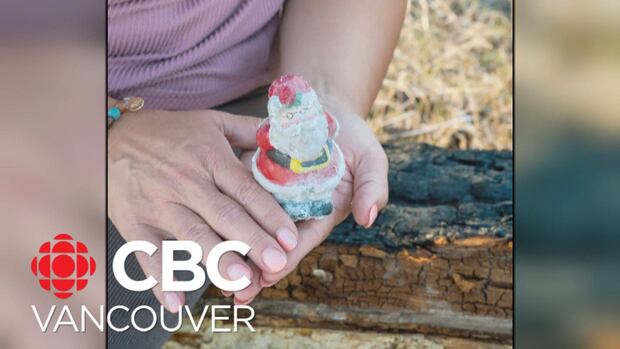A scuffed Santa-shaped salt shaker, a gnome that resembles a charcoal briquette and a small peach dish are all that’s left of Heather MacKay’s former six-bedroom house in south-central British Columbia.
MacKay’s home in West Kelowna, about 260 kilometres northeast of Vancouver, was one of dozens of properties torched by the McDougall Creek wildfire, which ripped through nearly 140 square kilometres of land last year.
Since then, the trinkets have become treasures and they are among the items to be featured in a New York exhibit next week, which aims to show world leaders at the UN the impact and damage that climate change is having on people’s lives.
The B.C. hairstylist said the trinkets were worth about $20 combined, but she treats them like they’re worth millions now because of the sentimental value of what they represent.

“I keep them in little domes, like the little glass domes and stuff,” MacKay told Nil Köksal, co-host of CBC’s As It Happens. “Because I swear if you looked at them too hard, they’d probably start disintegrating.”
The free one-day exhibit, to be held as world leaders convene for the UN General Assembly, is being organized by the non-profit Sierra Club Canada.
Five British Columbians are among the Canadians contributing items to the exhibition, as B.C. has faced a number of climate emergencies in the last few years, including some the province’s most destructive wildfire seasons on record happening since 2017.
Household items recovered from natural disasters in Canada will be displayed in New York as part of an exhibition for the United Nations’ Climate Week. Among the items are precious keepsakes from Heather MacKay, whose West Kelowna home was burned down during last year’s McDougall Creek wildfire.
“When people see those little things in my house and realize that’s all we had after … I’m 49 years old and that’s all I have from prior to that,” MacKay said in an interview with the CBC’s Chris Walker.
“And I just hope people see that it’s a real problem, that we’re suffering.”
Conscious of possessions after fire
The McDougall Creek wildfire started about 10 kilometres north of West Kelowna, a city of about 33,000 people, on Aug. 15, 2023. It grew quickly and fiercely, forcing the evacuation of tens of thousands of residents from their homes.
According to the B.C. Wildfire Service’s 2023 wildfire summary, the fire burned nearly 140 square kilometres of land.
MacKay said her property had been on evacuation alert before, so all she had was a carry-on bag that she took when she left — which means when her home was reduced to rubble, nearly everything she had went up in smoke.

“It was such a big house … when our adult children struggled in life, we were able to offer them a place to fall,” she said. “And we had a Ukrainian refugee live with us for seven months.”
The B.C. woman, who was able to find a new house near a local hospital, said the fire made her and her husband reflect on the occasionally poor uses of their money.

She said she now only shops at local establishments and farmers’ markets, as those were the shops that offered her help after the fire — not big box stores.
“If it doesn’t spark us joy, we don’t bring it into our house,” MacKay said.
“I just think about all the time and money I focused on things that are nothing, and I never want to be there again,” she added.
Exhibition organized during UN event
Diana Boston, a member of the Upper Nicola Band, is also among the British Columbians contributing items to the exhibit.
She saw her home’s basement underwater a few years ago due to destructive floods in Merritt, about 190 kilometres northeast of Vancouver.
In November 2021, an atmospheric river flooded large sections of the province and washed out major roadways linking the Interior and Lower Mainland. About one month’s worth of rain fell in the area in less than 48 hours.
All 7,000 residents of Merritt were forced to evacuate, and more than 600 houses were damaged, 300 of which required extensive repairs or demolition.

Boston’s stuffed Dalmatian, a childhood toy, will be on display in the exhibit.
She said she wants people to know that climate disasters can happen quickly and affect anyone.
Conor Curtis, communications manager of Sierra Club Canada, said the group hopes the exhibit will symbolise the impact of climate change as world leaders gather to discuss the future.
“It’s one thing to talk about these things and to understand them in a scientific way. It’s a totally different thing to see these objects that have come, again, from people’s homes,” Curtis said. “It brings home the fact that, you know, these are very real consequences.”
The one-day, pop-up exhibition is being held Tuesday at 148 East 40th Street in New York, during the UN General Assembly High-level Week and New York Climate Week.
